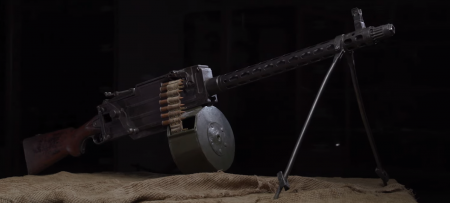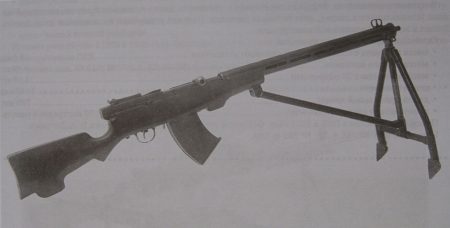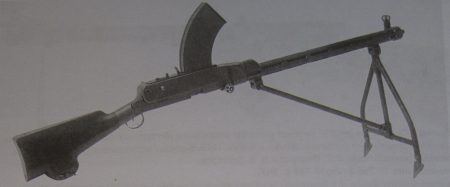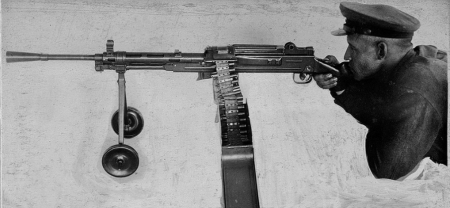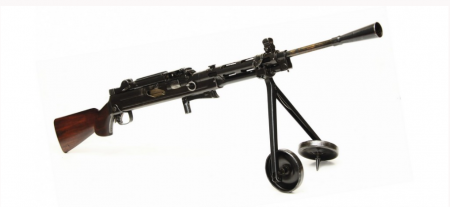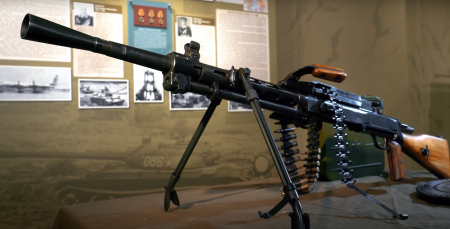The Long Road to the DP-27
May 9, 2021 Ian McCollum Light MGs, Prototype 28
This guest article written by Andrey Ulanov.
The Russian military first got acquainted with light machine guns in 1904, on the brink of the Russian-Japanese War. After having tested a few Madsen LMGs, the Army decided to make a purchase. However, most of the ordered batch did not arrive in time for war, so according to some sources, Madsens were first used during the 1905 rebellions, both by the government troops and the rebels.
Going forward, the Russian army focused its efforts on heavy machine gun due to limited capacity of Russian arms production industry. At the time, there was just one factory capable of manufacturing high tech military equipment (and in the early 20th century, machine guns were definitely considered high tech), located in Tula, Russia’s arms powerhouse since 1595.
As the Great War made the need for a light machine gun very clear, the Empire decided to build a new plant in Kovrov using Danish syndicate help (as in, equipment and engineers). Unfortunately, the revolutionary turmoil of 1917 did not allow the factory to be completed as Danes fled the country, taking most of the equipment with them, so the Madsen never became the Russian or Soviet machine gun.
Maxim-Tokarev LMG
The freshly minted Soviet Red Army initially tried to follow the German path by creating Maxim-Tokarev, a light version of the Maxim machine gun, similar to the German LMGs of World War I. However, the first batches drew a lot of criticism from the troops. Despite the fact that some of those could be attributed to the initial production difficulties, normal when developing a new weapon, the Red Army deemed the Maxim-Tokarev had “little potential”. It was heavy (not a great trait for a light machine gun) and complex. All further improvements led to the loss of resemblance to the original Maxim and consequently made the production even more complex. The situation called for designing a new light machine gun from scratch.
At the time, Soviets had great relationships with Weimar Republic and considered the German light machine guns very promising. Ten samples were purchased, including some tank-mounted models. While we cannot know exactly, these were presumably the MG-13 experimental versions.
However, before long the Red Army command had a new domestic option. The Degtyarev DP-27 was designed by Vasily Degtyarev, a disciple of General Vladimir Fedorov of “Fedorev Avtomat” fame. After creating several prototypes, the designers settled on the time-tested gas blowback scheme.
Choosing the feed system was not nearly as straightforward. The shape and rim of the Russian standard 7.62x54R cartridge made it unsuitable for either box-feeding or belt-feeding. The British .303 and the old French 8x50R Lebel rifle cartridges had the same problem. Fedorov tried to convince the leadership to adopt the Japanese 6.5x50mmSR Arisaka cartridge but to no avail. In the end, the Command decided on sticking to the good old 7.62x54R. Designing a reliable box magazine for it seemed nigh impossible, and cloth ammo belts had their own share of problems in the wet and cold of Russia (Soviets would not be able to produce metallic belts until WWII). So Degtyarev opted for a pan magazine, which not only could reliably feed 7.62x54R cartridges but also contained 47 rounds, way more than standard 20- or 30-round box magazines of competing light machine guns.
Experimental Fedorov LMG
On the other hand, the pan-feed system also had many flaws. The Army testers noted excessive “dead weight” (too much metal per cartridge). Pans were also complex and expensive to manufacture. In combat, sharing ammo between soldiers and reloading under fire were also far from simple. Even before World War II, the Red Army worked hard on designing a reliable alternative to pan-feeding DP-27, testing a variety of approaches from installing modular belt feeders and top-mounted box magazines to copying Japanese clip-fed systems off models captured during Khalkhin Gol battles in 1939.
Experimental DP-27 with top-mounted box magazine
At some point, Goryunov-Voronkov-Goryunov (yes, two different Goryunovs) model was developed. It was a belt-fed light machine gun and it was ready for testing even before the war but it never went into production and its design later contributed to SG-43, Russia’s most successful HMG of WWII.
Goryunov-Voronkov-Goryunov
Goryunov-Voronkov-Goryunov
After June 22, 1941, a steady flow of soldier complaints about the DP began from the frontlines. Most of them regarded the pan-related issues but some were new. The military complained about the carbon buildup in the gas system and recoil springs that often failed due to overheating as they were mounted directly under the air-cooled barrel. In 1942, the USSR held a competition for a new light machine gun. Simonov’s RPS LMG won and a small batch was produced but it never went into mass production. In 1943, Kalashnikov’s light machine gun was tested at the shooting range but failed to reliably feed the 7.62x54R from a high-capacity bottom-mounted box magazine. Definitely an ‘I told you so’ moment for Degtyarev.
RP-46, belt-fed modernization of the DP-27
As a result, no new light machine gun chambered for a rifle cartridge was ever adopted. The DP was modernized as DPM, with a more comfortable pistol grip, new bipods and a recoil spring moved to a cooler location at the back of the barrel. It even received a belt feed mechanism, which could be installed instead of a standard pan, and was relabeled as RP-46 machine gun. However, as the country stepped into the era of intermediate cartridges, LMGs chambering rifle cartridges became a thing of the past and Degtyarev moved on to design RPD-44, one Russia’s most known LMGs around the world.Y
